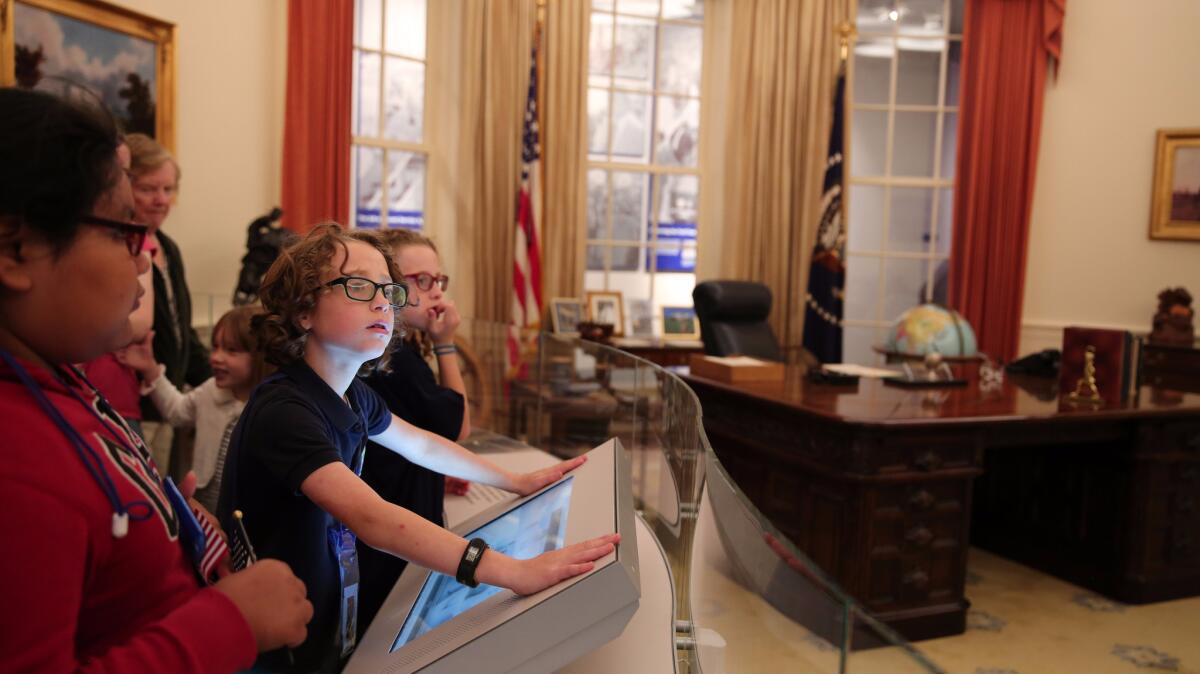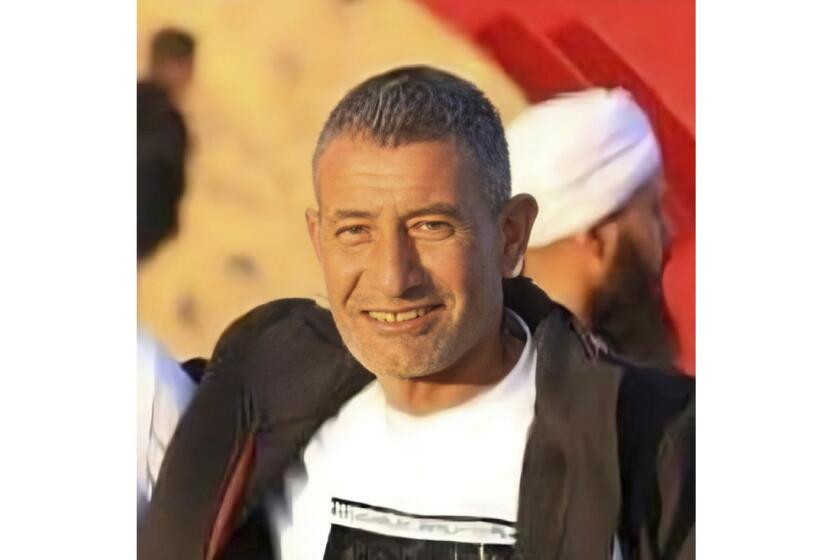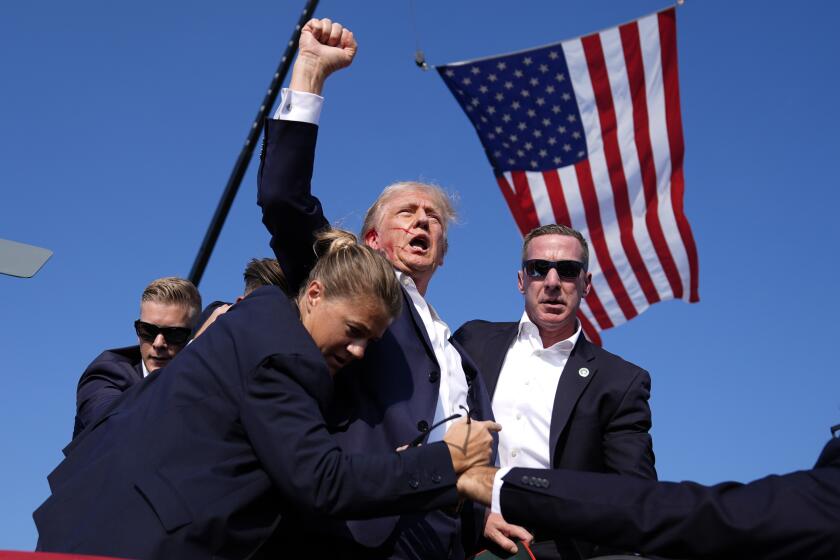Presidential museums’ challenge: reinventing themselves for new audiences
Seated shoulder to shoulder with school kids just outside the freshly revamped Gerald R. Ford Presidential Museum, former Vice President Dick Cheney twirled a small U.S. flag in his hands one blustery morning last week as he waited to speak about the edifice honoring his first White House boss.
“One of the things I worry about is we don’t do a very good job as a nation teaching history anymore,” Ford’s former chief of staff said to a crowd of 1,500 that included his predecessor in the job, former Defense Secretary Donald H. Rumsfeld. “This library and all that it represents does a magnificent job of telling the story of those days.”
As Chicago gears up to host a Barack Obama presidential museum and library, the 35-year-old Ford museum unveiled its second face-lift — a reminder that these institutions are not once-and-done endeavors. After the building goes up and the programming is complete, the task of reaching future generations doesn’t get any easier.
“Whether you’re an art museum or a presidential museum, you have to do this — reboot or redesign every 10 to 15 years,” Steve Ford, the former president’s youngest son, said in an interview. “And ours needed it.” The permanent exhibits at the Richard Nixon Presidential Library and Museum in Yorba Linda are undergoing a $15-million makeover too.
More than 40 years have passed since Ford took office after the historic resignation of Nixon, and like many institutions dedicated to past presidents, the museum has puzzled over how to remain compelling. Its previous update in 1997 introduced theaters for videos. Ford died in 2006 at the age of 93.
The most recent, $15-million reboot included a modernization and expansion of the museum built in Ford’s boyhood town to honor the man who stepped into the Oval Office at the height of the Watergate scandal.
The new project includes eight touch-screen stations, bringing the museum into the digital age, and adds a three-classroom education center for schoolchildren.
“The younger generation does not know who President Ford is,” said Joe Calvaruso, executive director of the Gerald R. Ford Presidential Foundation. “We need to share those moments. He was the only president from Michigan.”
Experts say attendance at the nation’s presidential libraries and museums generally dwindles over time. The National Archives and Records Administration puts pressure on individual libraries to produce strong attendance and public programming, including educational activities for kids, said Anthony Clark, who wrote a book about the presidential libraries.
Some augment attendance through temporary exhibits that are unrelated to presidential history. The Ford museum, for instance, significantly boosts its annual numbers by serving as a site for a huge annual art show for nearly three weeks each fall.
The museum drew 270,393 visitors last year, a surge from 88,632 in 2008, the year before it started hosting art-show competitors. In 1982, its first full year in operation, it drew 423,886 visitors — a record it has not matched since.
Chicago and its philanthropic community can and should expect periodic campaigns to rethink, refresh and upgrade the planned Obama center on the city’s South Side, experts say.
The Obama Foundation, still in its early phases, aims to stay engaged with the community and to use technology to develop a center for action, rather than just a library, said spokeswoman Amy Brundage.
Private foundations, typically led by a president’s family and allies, raise the funds for building, marketing and programming presidential libraries and museums while the federal government operates and maintains the facilities and archives, at a cost to taxpayers of about $700 million per decade, according to the National Archives.
The more recent libraries and future libraries also must have endowments that contribute to the operating expenses as well.
“Stay connected to the community because the community is what really supports the museum and the library,” said Steve Ford.

Clark estimates the taxpayer cost over a decade is closer to $1 billion when some capital projects are added.
“If you’ve got an ongoing need to justify the expense ... you have to show numbers,” he said. “As in, ‘How many butts have you got in the seats?’’’
The revamped Gerald R. Ford Presidential Museum and its newly built DeVos Learning Center opened June 7.
To tell the story of Ford, who rose to the presidency at a wrenching time and dealt with myriad crises in his short tenure, the museum crams a vast amount of material into its 12,000-square-foot permanent exhibit space.
While some presidential library scholars say these institutions tend to function as public relations machines, the Ford museum, at least in its earlier iterations, has done a better job than most in acknowledging the searing issues of his day, said Clark, author of “The Last Campaign: How Presidents Rewrite History, Run for Posterity & Enshrine Their Legacies.”
The museum includes a section on the Watergate scandal, including a wire cutter and penlight used by burglars to break into the Democratic National Committee headquarters. The foreign affairs exhibit displays the ladder used by Americans and South Vietnamese fleeing to the rooftop of the U.S. Embassy for evacuation during the defeat of South Vietnam.
The museum also displays the pistol used in a 1975 assassination attempt by Lynette “Squeaky” Fromme. A second assassination attempt occurred 17 days later. Near the gun is the Kevlar-lined raincoat subsequently worn by Ford as protection from bullets.
The eight new touch screens at more traditional exhibits allow users to dig deeper, reaching down to some intriguing tidbits. At the replica of the Oval Office, for instance, viewers find out that when Ford redecorated the office, oil paintings were hung in place of wall sconces that contained hidden microphones during Nixon’s tenure.
Bergen writes for the Chicago Tribune.
More to Read
Sign up for Essential California
The most important California stories and recommendations in your inbox every morning.
You may occasionally receive promotional content from the Los Angeles Times.









